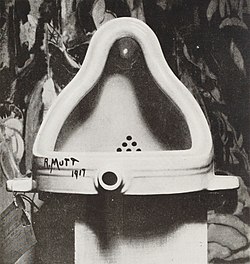Self-parody

Self-parody is parody of oneself or one's own work. As an artist accomplishes it by imitating his or her own characteristics, self-parody is potentially difficult to distinguish from especially characteristic productions (exempli gratia: a situation in which a litterateur's mannerisms are typically ponderous, sesquipedalian, and Latinizing).
Sometimes critics use the word figuratively to mean the artist's style and preoccupations appear as strongly (and perhaps as ineptly) in some work as they would in a parody. Such works may result from habit, self-indulgence, or an effort to please an audience by providing something familiar. Ernest Hemingway has frequently been a target for such comments. An example from Paul Johnson's book Intellectuals:
- Some [of Hemingway's later writing] was published nonetheless, and was seen to be inferior, even a parody of his earlier work. There were one or two exceptions, notably The Old Man and the Sea, though there was an element of self-parody in that too.
Political polemicists use the term similarly, as in this headline of a 2004 blog posting. "We Would Satirize Their Debate And Post-Debate Coverage, But They Are So Absurd At This Point They Are Their Own Self-Parody".[1]
The following are deliberate self-parodies or are at least often considered to be so:
- Chaucer's Tale of Sir Topas in the Canterbury Tales shows "Geoffrey Chaucer" as a timid writer of doggerel. It has been argued that the tale parodies, among other romances, Chaucer's own Troilus and Criseyde.[2]
- "Nephelidia",[3] a poem by A. C. Swinburne.
- "Municipal",[4] a poem by Rudyard Kipling.
- "Afternoon of a Cow", a short story by William Faulkner.
- Pale Fire, a novel by Vladimir Nabokov in the form of a long, pedantic, self-centered commentary on a much shorter poem. It may parody his commentary on his translation of Pushkin's Yevgeny Onegin; the commentary was highly detailed and much longer than the poem.
- "Errantry",[5] a poem by J. R. R. Tolkien that parodies his "Eärendil was a Mariner".
- The song "Chicken in Black", by Johnny Cash, parodies his persona as "the Man in Black". The accompanying video shows Cash robbing a bank dressed as a chicken.
- Several actors in Airplane!.
- In the film The Running Man, the actor Richard Dawson parodied his performances as the host of the game show Family Feud.
- The later James Bond films have often been called self-parodies.[6]
- Neko Majin Z, a manga by Akira Toriyama, parodies his successful manga Dragon Ball and Dragon Ball Z.
- The television actress and hostess Kelly Ripa has parodied her own work and public image on TV comedies.
- Many comedians, like Drew Carey, Jerry Seinfeld and Ray Romano, have parodied their own personalities and stand-up material on successful sitcoms.
- Arnold Schwarzenegger engaged in 130 minutes of intentional self-parody in the movie Last Action Hero, where he steps off-screen into the Real World. (In the Real World, he notices a standee touting Sylvester Stallone starring in Terminator 2: Judgment Day.)
- Robert De Niro in Meet the Parents and Analyze This.
- Ricky Gervais in Extras.
- Reefer Madness is considered by many to be a self parody, the anti-drug message is so exaggerated and over-the-top that the movie became a self parody as a result.
External links
- Sir Thopas and the Minstrel Style in Troilus from Writing Aloud (see References)
- "Nephelidia" from Representative Poetry Online
- "Municipal" from ReadBookOnLine.net
- "Errantry" from AntarcticaGalleries
- A review of the Bond film Die Another Day from The Film Tribune
- The Moderate Independent accuses Fox News of inadvertent self-parody
